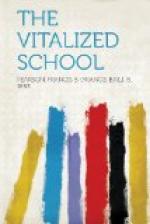=Art as an auxiliary.=—In a recent work of fiction a chapter opens with a picture of a little girl eating a slice of bread and butter which is further surmounted by apple sauce and sugar. If the author of the book “Agriculture and Life” had only caught a glimpse of this picture, he might have changed the title of his book to “Life and Agriculture.” He certainly would have given to the life element far more prominence than his book in its present form affords. His title makes a promise which the book itself does not redeem, more’s the pity. If science would use art as an ally, it need not be less scientific, and its teachings would prove far more palatable. The little girl with her bread and butter would prove quite as apt as an introductory picture for a book on agriculture as for a work of fiction. It matters not that agriculture includes so many other sciences, for life is the great objective of the study of all these, and the little girl exemplifies life.
=Relation of sciences to life.=—The pictures are practically endless with which we might introduce the study of agriculture—a boy in the turnip field, a milkmaid beside the cow, or Millet’s celebrated picture “Feeding the Birds.” And, sooner or later, pursuing our journey from such a starting point, we shall arrive at physiology, chemistry, botany, physics, meteorology, and geology, and still never be detached from the subject of life. In the school consciousness agriculture and domestic science seem far apart, but by right teaching they are made to merge in the subject of life. Upon that plane we find them to be complementary and reciprocal. In the same way chemistry, botany, and physiology merge in agriculture for the reason that all these sciences as well as agriculture have to do with life. In the traditional school chemistry is taught as chemistry—as a branch of science, and the learner is encouraged to seek for knowledge. In the vitalized school the truths of chemistry are no less clearly revealed, but, in addition, their relations to life are made manifest, and the learner has a fuller appreciation of life, because of his study of chemistry.
=Traditional methods.=—In the traditional school domestic science is taught that the girl may learn how to cook; but in the vitalized school the girl learns how to cook that she may be able to make life more agreeable and productive both for herself and for others. In the traditional school the study of agriculture consists of the testing of soils and seeds, working out scientific theories on the subject of the rotation of crops, testing for food values the various products of the farm, judging stock, studying the best method of propagating and caring for orchards, and testing for the most economic processes for conserving and marketing crops. In the vitalized school all this is done, but this is not the ultimate goal of the study. The end is not reached until all these ramifications have touched life.




